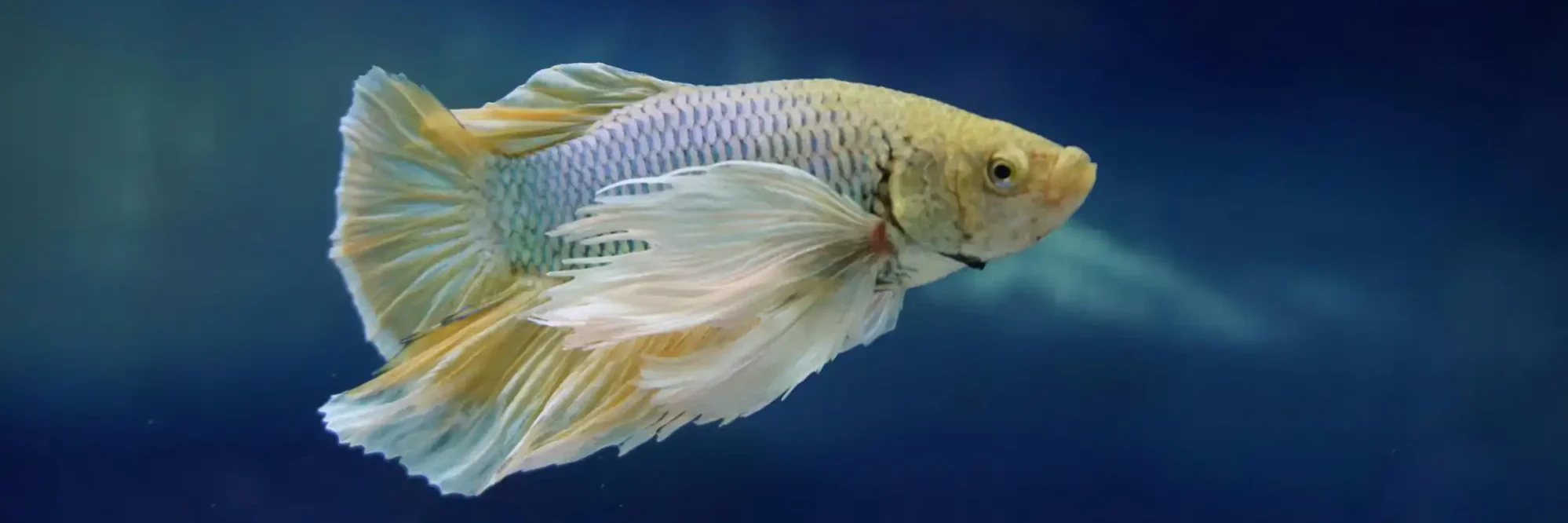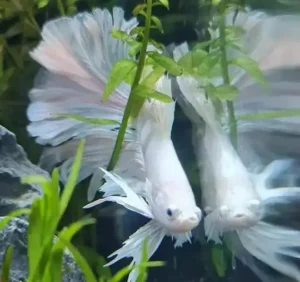The Complete Guide to Betta Fish
Origin of Betta Fish
Betta fish, widely recognized as Siamese fighting fish, is a part of the gourami family native to Southeast Asia that has a rich diversity of ecosystems. Precisely speaking, they are originated from Thailand and have been domesticated for at least 1,000 years, making them one of the longest-domesticated fish species. Other reports place its origin in Vietnam, Cambodia, and Malaysia, along with Thailand.
In Thailand, some 150 years ago, bettas were hunted by children and adults of the locality, and were then trained to fight with one another. The game of their fighting became so popular among adults that they used to gamble on their fighting. Interestingly, the winner was not the one who hurt the opponent most, but instead, the one who did not back down even after hours of fighting. The most resilient one was considered as the village champion. Nowadays, fighting betta fish is illegal in many countries and is considered animal abuse.

History and Nomenclature
Betta was first outed from Thailand when a king of Siam in 1840 gave some of them to a famous zoologist, Theodore Cantor, who studied the fish and bred them. He wrote a research publication and first scientifically named it Macropodus Pugnax, meaning aggressive fish with long fins. In the late nineteenth century, it was discovered that the fish belongs to the genus Betta, so they were named Betta Pugnax. The word betta likely derives from the Latin ‘ikan bettah,’ where ikan means ‘fish’ and betta refers to an ancient worrier tribe.
Later, Charles Tate Regan discovered that the scientific name Pugnax had been taken for another species. Hence, it was renamed Betta Splendens, which means beautiful worrier. The word Splendens reflects the exquisite nature of the fish.
Before being introduced into Western countries and the rest of the world, the fish was known by its common name of Siamese fighting fish, which reflects the combination of its origin, Siam, and the aggressive nature of its fighting.
The genus Betta comprises 73 species, of which the Betta Splendens became the most popular worldwide due to its exquisite nature. Other species within betta genus includes bubble-nest builders like B. imbellis, B. smaragdina, and B. siamorientalis, and mouth-brooding species like B. pugnax and B. ferox.
The local communities of Thailand used the name ‘plakat’ for all members of the genus Betta, which means ‘biting fish.’ When the people talk about betta fish, they generally mean ‘betta splendens’, which is considered the start of the betta world. Its vibrant colors, flowing fins, and long history of selective breeding makes it the key identifier for the entire genus.
Natural Habitats of Betta fish
Becoming aware of the natural habitats of betta fish is crucial when keeping them in captivity. Understanding their natural habitats helps us create similar conditions in their aquariums, such as water temperature, pH level, and plants. Replicating the conditions, they are naturally adapted to, ensures a healthier environment that allows betta fish to exhibit natural behaviors and lead a stress-free life. Understanding the considerations for betta’s natural habitats also makes it easy for their owners to give the best care for betta fish.
As mentioned earlier, betta fish are endemic to Southeast Asia, known for shallower waters, often stagnant or slow-moving waters, with abundant vegetation such as marshes, floodplains, and paddy fields.
The climatic conditions, such as water, temperature, and chemistry, change quickly in these regions, where the pH level ranges from 6.9 to 8.2, and temperature ranges from 59°F to 100°F. The regions are also vulnerable to drought, enabling the betta fish to thrive in shallow waters.
The dense plant life offers shelter and provides a breeding ground and hunting area for small insects and larvae, which are bettas’ primary food source. It also protects bettas from predators and helps mitigate aggression between their males.
In addition to more extensive water bodies, bettas can often be found in small ditches and puddles. These microhabitats can form during the wet season and may be disconnected from larger water systems. Bettas’ ability to thrive in such limited and variable conditions demonstrates their remarkable resilience and adaptability.
After understanding their natural habitats, you’ll hopefully realize that siamese fighting fish are exceptionally adaptable and resilient. Surviving in these harsh and variable conditions and environments sets the betta fish apart from other freshwater fish where they can’t survive. This uniqueness justifies their widespread popularity as pets and successful colonization of various water bodies worldwide.
Adaptations for Survival
During the rainy season, many Southeast Asian areas experience significant flooding, creating temporary habitats like flooded plains and swamps. These natural habitats in the wild were shallow waters that often dried out during famines.
Additionally, the higher air temperatures in these regions cause rapid evaporation of gases, leading to low oxygen levels in the bettas’ natural habitats. These natural happenings led them through the evolutionary stages of developing a particular organ known as the labyrinth organ, enabling them to breathe atmospheric air.
This remarkable adaptation to breathe air gives bettas the advantage of exploring a variety of habitats in the wild. It enables them to explore the shallow edges of water bodies where they gracefully hunt for prey and establish their territories.
While the labyrinth organ allows air breathing, it doesn’t mean dirty water is acceptable; clean water with surface access is still vital for overall health.
Breeding Betta Fish
Though bettas were initially bred for fighting purposes, due to their fighting becoming illegal, breeders now breed them for their stunning finnage, vibrant colors, and unique body shapes. Over time, breeders and hobbyists focused less on fighting traits and more on appearance. This led to developing different types of betta fish, such as veil tail, halfmoon, double tail, and many others.
Then came the Crowntail in the late 1990s, bred in Indonesia and recognized for its dramatic spiky rays that resemble a crown.
Despite all this selective breeding of bettas, they still show fighting nature if the two males are kept in the same tank.
Wild vs. Domestic Betta
Wild betta fish don’t look like the fancy ones in pet stores. They have short fins and dull colors like brown or green. These colors help them hide in the wild by blending into their natural surroundings. Pet bettas, or domestic ones, on the other hand, look very different. They have long, flowing fins and bright colors like red, blue, or even shiny metallic. People bred them to look pretty. That’s why they come in so many shapes and colors today.
Wild bettas are picky eaters and may prefer live or natural foods, while domestic bettas are more adaptable to pellets and frozen food. The wild ones are less common due to their more care work, which is why they are considered not beginner-friendly. On the other hand, domestic bettas are best for beginners due to their easy care.

Wild bettas have special courtship behaviors that help them attract a mate. In domestic bettas, these rituals can sometimes be different or less successful, especially in long-finned types, because their big fins can get in the way.
Normal Betta Behaviors
After knowing about their natural habitats, it’s time to understand the typical behaviors of betta splendens. Bettas are very delicate finned fish that sometimes behave in a way that confuses a beginner about whether they act normal or abnormal. Below are some customary etiquettes of bettas; they usually exhibit in the wild, and you might experience these behaviors when you get a betta from the store.
Flaring
If you notice a betta flaring at you, it’s not because he thinks you look fishy. A betta flare is the expansion of its gills, a reaction to perceived threats such as another betta or fish. This territorial display of flaring, particularly in male bettas, makes them appear more prominent to threaten potential predators. In captivity, where there are no real threats, bettas may still exhibit flaring when they encounter their reflection or see the background.
It’s normal for a betta to flare for 2-3 minutes a day. However, if flaring persists for a long time, it might indicate potential threats from tank mates or prolonged exposure to a mirror or background. This can stress your betta and lead to severe health issues.

Snapshot of the betta flaring his gills at a finger. The left one is before flare and the right one is after flare.
If your betta fish isn’t flaring, you can encourage this behavior by placing a mirror in front of it for five minutes or less. If it still doesn’t flare, it might be stressed or just not aggressive. You could also try introducing a female betta or other tank mate, but be cautious with the possibility of betta’s reaction for fighting.
Bubble Nest Building
Wild bettas inhabit in slow-moving waters such as shallow streams and canals. The low water flow in these areas helps bettas establish territories and build their bubble nests without the disruption caused by strong currents.
Bubble nests are floating clusters created from saliva by male bettas. In the wild, male bettas make bubble nests to attract females for breeding. These nests provide an unassailable environment for their eggs until they hatch. This natural behavior indicates a healthy, mature male ready for potential mating.
There is controversy regarding bubble nests; some pet owners believe that a betta makes bubble nests indicate happiness, while others disagree. Having cared for hundreds of bettas at the pet store, making bubble nests does not necessarily mean a betta is happy; however, it does indicate a certain level of health and wellness.
I have never observed a severely sick betta building bubble nests, although in some cases, they might still create them because it’s their instinct. While bettas are kept in small bowls with no accessories in pet stores, they still make floating masses. I conclude that it’s a positive sign, indicating that your betta is healthy and will thrive if given proper care.
Some betta keepers suggest removing these bubble nests when they don’t want bettas breeding. But never do that. Bettas are compassionate and emotional creatures who might be disturbed by the destruction of these nests.
Aggression
Where there are bettas, aggression inherently follows them. This instinctive behavior is one of the most prominent traits of male bettas. It is primarily due to their territorial nature of establishing dominance in their territory. They may chase, nip, or fight other male bettas or similarly colored and finned fish.
Female bettas may reveal aggression, but they are less fierce than males. Female bettas are more communal and can live in groups. Because of this aggressiveness, keeping two male betta fish in the same tank is discouraged. Having two male bettas is still risky, even in a large tank with plenty of hiding spots.
Laying at Bottom
When customers purchased betta fish from the pet store where I worked, they often worried about the betta lying at the bottom of the tank. Most pet owners, especially beginners, mistakenly believe their betta fish are sick when merely sleeping.
Betta fish take breaks and rest on leaves, tank decorations, or the bottom of the tank. These occasional periods are typically nothing to be concerned about. They may appear motionless, but this is a normal behavior. However, if they stay at the bottom long, it could be a severe issue. In that case, observe it closely for a few days and watch for any signs of infection or stress.
Actively Swimming
A healthy betta loves to stay active and explore its tank. You’ll often see it swimming around, checking out decorations, hiding in live plants, and even the gravel at the bottom. This behavior usually means your betta is curious, looking for food, or just keeping an eye on its territory. If your fish is doing this regularly, it’s a good sign—it shows they’re feeling good and staying engaged with their surroundings.
Resting Near the Bottom
Sometimes your betta will just chill and stay still. It might rest near the bottom, on a leaf, or lean against a decoration. Its colors may look a bit dull while it sleeps. Don’t worry—it’s just resting. Bettas need sleep too, just like us. Make sure to give it cozy spots to relax, like leaf hammocks or smooth logs. That’s what they’d use in the wild.
Spitting Out Food
It’s common to see betta’s spit out their food or pellets, and there can be various reasons for this behavior.
-
- Size of food: The food you are giving might be too large for bettas to swallow comfortably. They spit out the food and prefer to macerate it to try it again later. Bettas have small mouths and tiny stomachs of their eye sizes, so it’s better to soak the food for a few minutes and then break it into pieces before feeding it to them.
- Texture and hardness: If the food is too hard or has a rough texture, the betta will definitely spit it out.
- Overfeeding: If you feed your betta too much at once, he will spit out the excess as he would not need anymore. Overfeeding can be detected by examining the betta for stress.
- Preference: Bettas are picky eaters and prefer one type of food and taste over the other. He will show dislike of the food you are giving by spitting it out. It has happened to mine, even though I gave him a perfectly sized food specially made for bettas. But he disliked it and spit it out. I didn’t force it; instead, I bought him food of his choice.
To know about the best food for your betta fish and its feeding schedule, read our complete article.
Abnormal Behaviors and Appearance
- Clamped fins – Your betta’s fins look tight and folded. This can mean stress, sickness, or cold water.
- Lethargy or no movement – If your fish is unusually lazy or just lying around, it could be stressed, sick, too cold, or the water quality might be poor.
- Faded colors – A sudden loss of color might mean stress, illness, or fear. A slight fade during sleep is normal, though.
- Glass surfing or pacing – Constantly swimming up and down the glass? That’s usually stress, boredom, or trying to escape a small or uncomfortable tank.
- Rubbing against objects – Also called “flashing.” This could mean parasites or skin irritation.
- Not eating – Loss of appetite is often linked to illness, stress, or dirty water.





